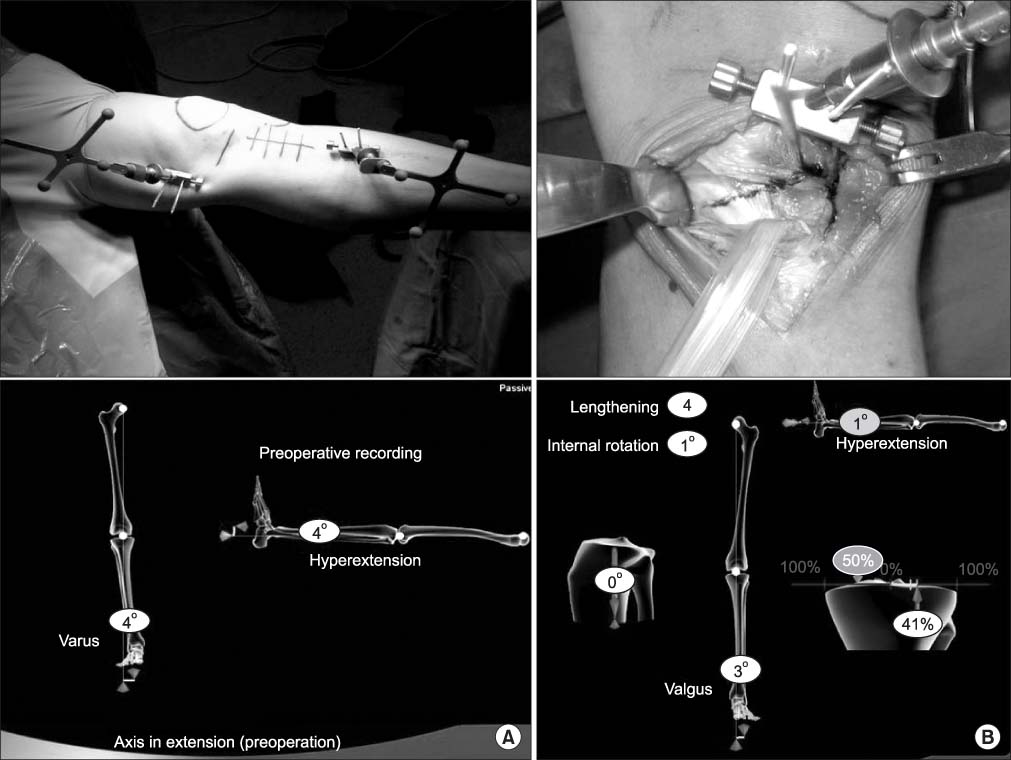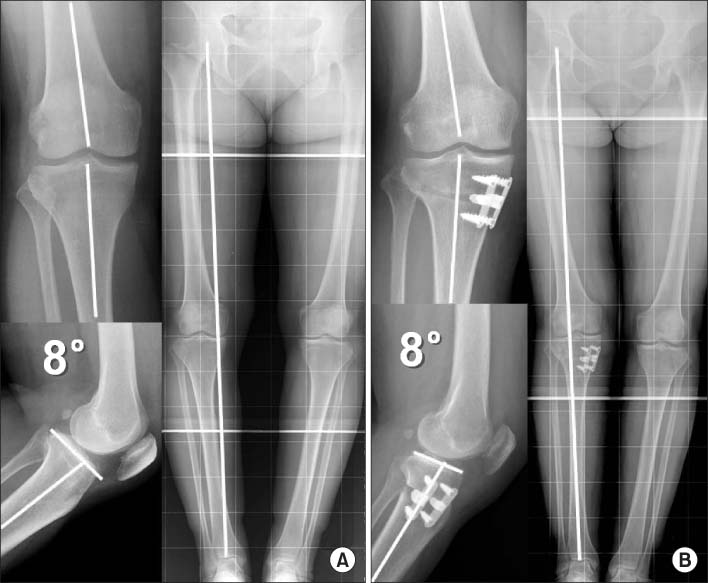J Korean Orthop Assoc.
2014 Apr;49(2):107-117. 10.4055/jkoa.2014.49.2.107.
Navigation Guided Open Wedge High Tibial Osteotomy
- Affiliations
-
- 1Department of Orthopaedic Surgery, Center for Joint Disease, Chonnam National University Hwasun Hospital, Hwasun, Korea. eksong@chonnam.ac.kr
- KMID: 2185215
- DOI: http://doi.org/10.4055/jkoa.2014.49.2.107
Abstract
- Navigation systems are currently being widely used in orthopedic surgery. The mechanical axis alignment can be judged accurately via a navigation system. High tibial osteotomy (HTO) is a procedure that aims to change the mechanical axis of the lower limb, transferring the body weight across healthy articular cartilage. Several studies have shown that accurate correction is the leading predictor for success. And, by using a navigation system, accurate multiplane measurements of the lower limb alignment can be performed intraoperatively in real time, and alignment adjustments can be made as the surgeon desires. Compared with the conventional cable-method, computer navigation significantly improves the accuracy of postoperative leg axis, reduces correction variability with fewer outliers, and reduces radiation time. This paper reviews the advantages, clinical results, complications, pitfalls, and posterior tibial slope control in navigation guided open wedge HTO.
Keyword
MeSH Terms
Figure
Reference
-
1. Amendola A, Panarella L. High tibial osteotomy for the treatment of unicompartmental arthritis of the knee. Orthop Clin North Am. 2005; 36:497–504.
Article2. Jakob RP, Jacobi M. Closing wedge osteotomy of the tibial head in treatment of single compartment arthrosis. Orthopade. 2004; 33:143–152.3. Dowd GS, Somayaji HS, Uthukuri M. High tibial osteotomy for medial compartment osteoarthritis. Knee. 2006; 13:87–92.
Article4. Marti CB, Gautier E, Wachtl SW, Jakob RP. Accuracy of frontal and sagittal plane correction in open-wedge high tibial osteotomy. Arthroscopy. 2004; 20:366–372.
Article5. Hernigou P, Medevielle D, Debeyre J, Goutallier D. Proximal tibial osteotomy for osteoarthritis with varus deformity. A ten to thirteen-year follow-up study. J Bone Joint Surg Am. 1987; 69:332–354.6. Parker DA, Viskontas DG. Osteotomy for the early varus arthritic knee. Sports Med Arthrosc. 2007; 15:3–14.
Article7. Bae DK, Yoon KH, Kwon OS, Kim YC, Shin DJ. Results and survivorship of high tibial osteotomy. J Korean Orthop Assoc. 2002; 37:357–363.
Article8. Ellis RE, Tso CY, Rudan JF, Harrison MM. A surgical planning and guidance system for high tibial osteotomy. Comput Aided Surg. 1999; 4:264–274.
Article9. Wright JG, Treble N, Feinstein AR. Measurement of lower limb alignment using long radiographs. J Bone Joint Surg Br. 1991; 73:721–723.
Article10. Dahl MT. Preoperative planning in deformity correction and limb lengthening surgery. Instr Course Lect. 2000; 49:503–509.11. Moreland JR, Bassett LW, Hanker GJ. Radiographic analysis of the axial alignment of the lower extremity. J Bone Joint Surg Am. 1987; 69:745–749.
Article12. Amin DV, Kanade T, DiGioia AM 3rd, Jaramaz B. Ultrasound registration of the bone surface for surgical navigation. Comput Aided Surg. 2003; 8:1–16.
Article13. Chen TK, Abolmaesumi P, Pichora DR, Ellis RE. A system for ultrasound-guided computer-assisted orthopaedic surgery. Comput Aided Surg. 2005; 10:281–292.
Article14. Pitto RP, Graydon AJ, Bradley L, Malak SF, Walker CG, Anderson IA. Accuracy of a computer-assisted navigation system for total knee replacement. J Bone Joint Surg Br. 2006; 88:601–605.
Article15. Rosenow JM, Sootsman WK. Application accuracy of an electromagnetic field-based image-guided navigation system. Stereotact Funct Neurosurg. 2007; 85:75–81.
Article16. Stiehl JB, Heck DA. Six sigma analysis of computer-assisted surgery tracking protocols in TKA. Clin Orthop Relat Res. 2007; 464:105–110.
Article17. Stulberg SD, Loan P, Sarin V. Computer-assisted navigation in total knee replacement: results of an initial experience in thirty-five patients. J Bone Joint Surg Am. 2002; 84:Suppl 2. 90–98.18. Song EK, Seon JK, Park SJ, Yoon TR, Park KS, Kim SK. Comparison of accuracy of navigation between infrared optical and electromagnetic systems. J Korean Orthop Assoc. 2009; 44:68–75.
Article19. Noyes FR, Goebel SX, West J. Opening wedge tibial osteotomy: the 3-triangle method to correct axial alignment and tibial slope. Am J Sports Med. 2005; 33:378–387.
Article20. Paley D, Herzenberg JE, Tetsworth K, McKie J, Bhave A. Deformity planning for frontal and sagittal plane corrective osteotomies. Orthop Clin North Am. 1994; 25:425–465.
Article21. Hankemeier S, Hufner T, Wang G, et al. Navigated open-wedge high tibial osteotomy: advantages and disadvantages compared to the conventional technique in a cadaver study. Knee Surg Sports Traumatol Arthrosc. 2006; 14:917–921.
Article22. Iorio R, Vadalà A, Giannetti S, et al. Computer-assisted high tibial osteotomy: preliminary results. Orthopedics. 2010; 33:82–86.
Article23. Keppler P, Gebhard F, Grützner PA, et al. Computer aided high tibial open wedge osteotomy. Injury. 2004; 35:Suppl 1. S-A68–S-A78.
Article24. Lee DH, Nha KW, Park SJ, Han SB. Preoperative and postoperative comparisons of navigation and radiologic limb alignment measurements after high tibial osteotomy. Arthroscopy. 2012; 28:1842–1850.
Article25. Krettek C, Miclau T, Grün O, Schandelmaier P, Tscherne H. Intraoperative control of axes, rotation and length in femoral and tibial fractures. Technical note. Injury. 1998; 29:Suppl 3. C29–C39.
Article26. Kawakami H, Sugano N, Yonenobu K, et al. Effects of rotation on measurement of lower limb alignment for knee osteotomy. J Orthop Res. 2004; 22:1248–1253.
Article27. Iorio R, Pagnottelli M, Vadalà A, et al. Open-wedge high tibial osteotomy: comparison between manual and computer-assisted techniques. Knee Surg Sports Traumatol Arthrosc. 2013; 21:113–119.
Article28. Reising K, Strohm PC, Hauschild O, et al. Computer-assisted navigation for the intraoperative assessment of lower limb alignment in high tibial osteotomy can avoid outliers compared with the conventional technique. Knee Surg Sports Traumatol Arthrosc. 2013; 21:181–188.
Article29. Akamatsu Y, Mitsugi N, Mochida Y, et al. Navigated opening wedge high tibial osteotomy improves intraoperative correction angle compared with conventional method. Knee Surg Sports Traumatol Arthrosc. 2012; 20:586–593.
Article30. Kim SJ, Koh YG, Chun YM, Kim YC, Park YS, Sung CH. Medial opening wedge high-tibial osteotomy using a kinematic navigation system versus a conventional method: a 1-year retrospective, comparative study. Knee Surg Sports Traumatol Arthrosc. 2009; 17:128–134.
Article31. Bae DK, Song SJ, Yoon KH. Closed-wedge high tibial osteotomy using computer-assisted surgery compared to the conventional technique. J Bone Joint Surg Br. 2009; 91:1164–1171.
Article32. Hankemeier S, Hufner T, Wang G, et al. Navigated intraoperative analysis of lower limb alignment. Arch Orthop Trauma Surg. 2005; 125:531–535.
Article33. Song EK, Seon JK, Park SJ, Seo HY. Navigated open wedge high tibial osteotomy. Sports Med Arthrosc. 2008; 16:84–90.
Article34. Song EK, Seon JK, Park SJ. How to avoid unintended increase of posterior slope in navigation-assisted open-wedge high tibial osteotomy. Orthopedics. 2007; 30:S127–S131.35. Baur H, Schuh A. CT- free computer navigated high tibial osteotomy (HTO) in medial osteoarthritis of the knee. J Bone Joint Surg Br. 2006; 88:S98.36. Maurer F, Wassmer G. High tibial osteotomy: does navigation improve results? Orthopedics. 2006; 29:S130–S132.37. Dejour D, Bonin N, Locatelli E. Tibial anticurvatum osteotomies. Oper Tech Sports Med. 2000; 8:67–70.38. Giffin JR, Vogrin TM, Zantop T, Woo SL, Harner CD. Effects of increasing tibial slope on the biomechanics of the knee. Am J Sports Med. 2004; 32:376–382.
Article39. Hohmann E, Bryant A, Imhoff AB. The effect of closed wedge high tibial osteotomy on tibial slope: a radiographic study. Knee Surg Sports Traumatol Arthrosc. 2006; 14:454–459.
Article40. Agneskirchner JD, Hurschler C, Stukenborg-Colsman C, Imhoff AB, Lobenhoffer P. Effect of high tibial flexion osteotomy on cartilage pressure and joint kinematics: a biomechanical study in human cadaveric knees. Winner of the AGA-DonJoy Award 2004. Arch Orthop Trauma Surg. 2004; 124:575–584.41. Lobenhoffer P, Agneskirchner JD. Improvements in surgical technique of valgus high tibial osteotomy. Knee Surg Sports Traumatol Arthrosc. 2003; 11:132–138.
Article42. Yim JH, Seon JK, Song EK. Posterior tibial slope in medial opening-wedge high tibial osteotomy: 2-D versus 3-D navigation. Orthopedics. 2012; 35:60–63.
Article43. Saragaglia D, Roberts J. Navigated osteotomies around the knee in 170 patients with osteoarthritis secondary to genu varum. Orthopedics. 2005; 28:S1269–S1274.
Article
- Full Text Links
- Actions
-
Cited
- CITED
-
- Close
- Share
- Similar articles
-
- Navigation versus Radiographic Measurements in the Open-Wedge High Tibial Osteotomy using Computer Assisted Surgery (CAS)
- A Comparative Study of the Navigated and Radiographic Measurements in Open and Closed Wedge High Tibial Osteotomy with Computer Assisted Surgery
- Severe Genu Recurvatum after a Closing-wedge High Tibial Osteotomy: A Case Report
- Comparison of Mechanical Axis and Dynamic Range Assessed with Weight Bearing Radiographs and Navigation System in Closed Wedge High Tibial Osteotomy
- Computer-Assisted Navigation in High Tibial Osteotomy








